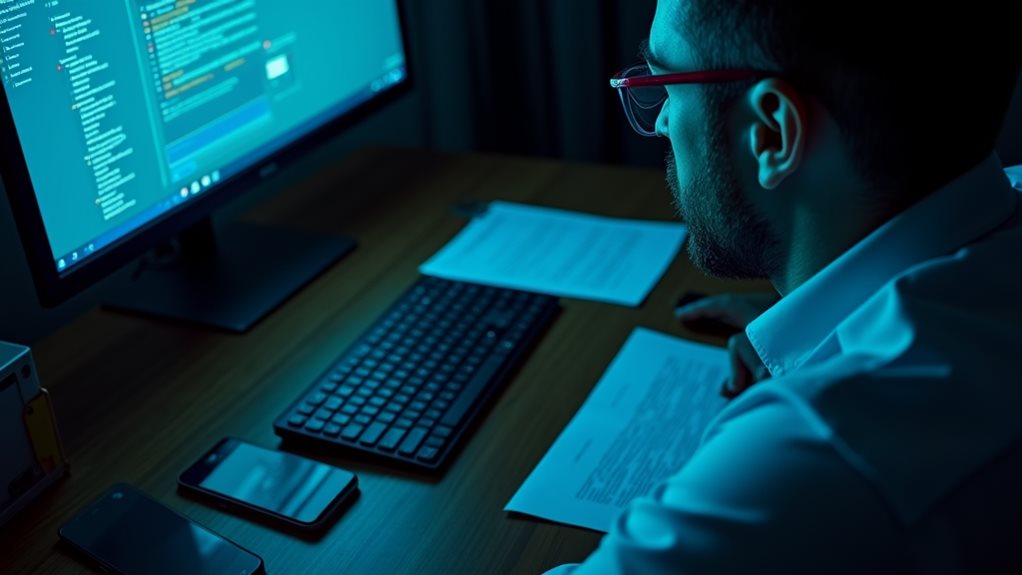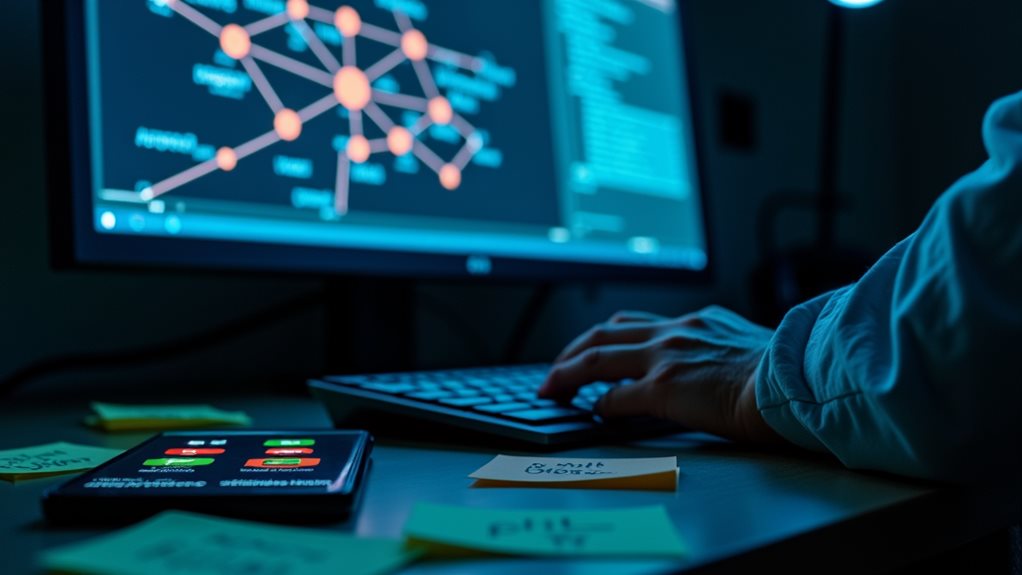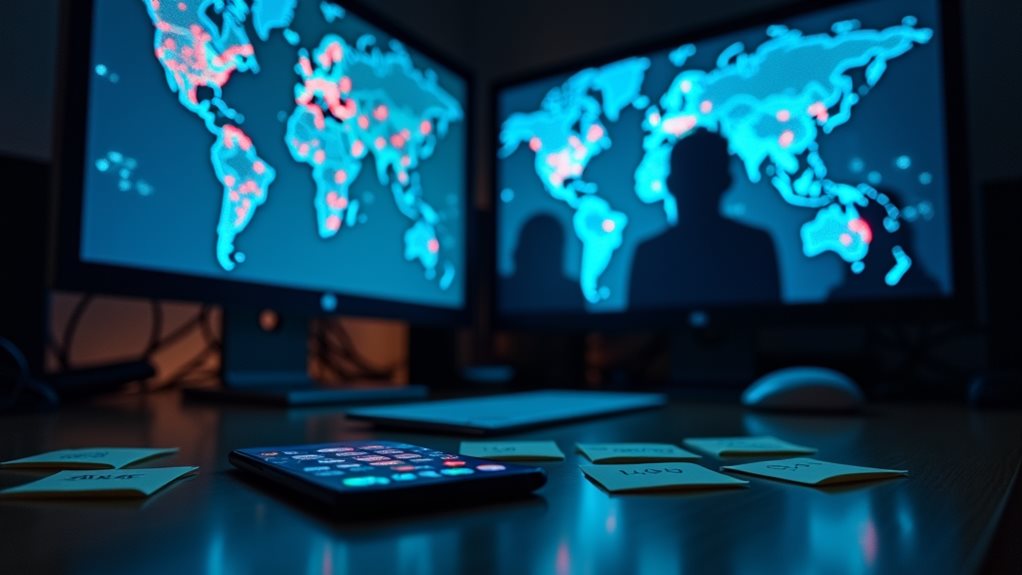Yes, you can trace a non-fixed VoIP number, but it's more complex than tracking traditional phone numbers. You'll need specialized tools like Truecaller or Wireshark for packet analysis, along with proper legal authorization to access Call Detail Records (CDRs) and subscriber information. While VoIP numbers are designed to be mobile and encrypted, combining multiple tracking methods, including IP geolocation and network monitoring, can help identify patterns and origins. Keep in mind that privacy laws and technical limitations may restrict your tracking capabilities, and unauthorized tracing attempts can have serious legal consequences. Understanding the complete tracking process will enhance your chances of successful number identification.
Understanding Non-Fixed VoIP Numbers
Non-fixed VoIP numbers represent a modern evolution in digital communications, operating independently from physical locations or specific devices. These numbers rely on internet data packets for transmitting calls and audio information.
You'll find that these numbers offer remarkable flexibility, as you can secure them with just an email address and payment method, making them perfect for today's dynamic business environment. When you're exploring non-fixed benefits, you'll appreciate how these numbers can adapt to your changing needs. These virtual numbers are harder to trace than traditional fixed VoIP numbers since they're not tied to physical addresses. Moreover, implementing strong authentication methods with your VoIP provider can enhance the security of these numbers.
What makes these numbers particularly valuable in VoIP applications is their ability to transcend geographical boundaries.
You're not tied to a specific area code – instead, you can choose one that best serves your business interests, even if you're operating from a different region entirely. This means you can maintain a local presence in multiple markets without the need for physical offices.
Plus, you'll discover that these numbers work seamlessly across various devices, from your smartphone to your laptop, ensuring you're always connected regardless of your location.
As your team grows or changes, you can easily reassign these numbers, making them an ideal solution for evolving organizations that value adaptability and efficient communication management.
Common Tracing Methods
While these digital numbers offer remarkable flexibility, tracking them down requires specific methods and tools. You'll find that several reliable approaches can help you trace non-fixed VoIP numbers, each offering unique advantages depending on your situation.
One of your most accessible options is performing a reverse lookup using specialized databases like Truecaller or Spokeo. These tools can provide valuable information about the caller's identity and location, though accuracy isn't always guaranteed with VoIP numbers. The 69 feature can also help you identify recent callers by automatically returning their last incoming call.
You can also dive deeper by examining call logs and CDRs, which often reveal patterns and IP addresses associated with the calls. VoIP providers maintain detailed call recording logs for each communication session, making it easier to analyze call log data and identify patterns in communication.
When you're dealing with more complex cases, IP address tracking becomes particularly useful. You'll need to extract the IP address from call records and use lookup tools to determine the approximate location and service provider.
However, it's important to understand that you might need legal authorization for accessing certain information. In many cases, working with law enforcement becomes necessary, especially when dealing with suspicious calls or potential criminal activity. They can help you navigate the legal requirements and coordinate with VoIP providers to obtain the necessary tracking information.
Legal Requirements and Restrictions

Before attempting to trace any non-fixed VoIP number, you must understand the strict legal framework that governs this process.
You'll need proper legal authorization, typically through court orders or warrants, to access any VoIP call records or user information. The legal frameworks in place protect user privacy and require demonstrating legitimate cause for investigation. Service providers like CloudTalk maintain strict security protocols to protect customer data.
When you're dealing with international calls, you're facing even more complex challenges. Different countries maintain their own privacy laws and data protection regulations, which means you'll need to navigate multiple legal systems to trace calls across borders. Using E911 services can help ensure emergency services can trace calls when necessary.
If you're working with law enforcement, they'll need to coordinate with international agencies and obtain necessary authorizations.
The privacy implications of tracing VoIP numbers can't be overlooked. You'll find that VoIP providers and ISPs have strict policies about sharing user data, and unauthorized attempts at tracing can result in serious legal consequences.
If you need to trace a non-fixed VoIP number, your best course of action is working with law enforcement agencies who understand these requirements and can pursue legal channels properly.
Technical Tools for Tracking
Once you've secured the proper legal authorizations, you'll need specialized technical tools to effectively trace non-fixed VoIP numbers. The good news is that today's VoIP technology offers numerous sophisticated tracking options that can greatly improve your tracing accuracy.
You'll want to start with network analysis tools like Wireshark, which lets you capture and examine call packets in detail. VoIPmonitor can analyze over 100,000 calls simultaneously on a single server, making it ideal for large-scale tracing operations. These tools reveal vital information such as timestamps, IP addresses, and protocols used during calls. Network logs are instrumental in identifying the exact source and destination of each call. Additionally, understanding network latency can help you determine if there are delays affecting call quality during your tracing process.
For more thorough monitoring, you can utilize VoIPmonitor or SolarWinds VoIP & Network Quality Manager to track call quality metrics and gather detailed session data.
Your tracking efforts will be more successful when you combine multiple approaches. Consider using third-party tracing services that provide access to Call Detail Records (CDRs) and VoIP number databases.
These services, along with packet sniffing techniques and real-time analysis capabilities, give you a complete picture of call patterns and origins. Monitoring crucial metrics like jitter, latency, and packet loss is essential for maintaining call quality while you're conducting your trace.
Challenges in VoIP Number Tracing

Despite recent technological advances, tracing non-fixed VoIP numbers presents several significant challenges that you'll need to understand. When you're dealing with VoIP technologies, you're facing multiple layers of complexity that make traditional tracking methods less effective.
One of your biggest tracing challenges will be maneuvering through the technical hurdles. VoIP calls are routed through multiple internet servers, and the data is split into packets that travel different pathways. You'll also encounter strong encryption and security measures that protect user privacy, making it harder to access necessary information. This complexity increases as VoIP technology converts voice to packets during transmission. With approximately 46% of illegal calls utilizing VoIP technology, the challenge of tracing becomes even more critical. Compliance with data retention laws ensures that providers maintain necessary records for effective tracing.
If the caller uses a VPN, you're looking at an additional layer of complexity.
Legal and privacy concerns create another substantial roadblock. You'll need proper authorization and often law enforcement involvement to access user data, as VoIP providers must comply with strict privacy laws.
The dynamic nature of non-fixed VoIP numbers adds to your difficulties, as these numbers aren't tied to physical locations and can be easily reassigned. When you factor in limited access to call logs and the potential for anonymous calling, you're dealing with a tracking process that requires significant expertise and resources.
Network Analysis Techniques
While tracing non-fixed VoIP numbers presents notable challenges, effective network analysis techniques can help you overcome many of these obstacles. By using specialized tools and methods, you'll be able to gather essential information about VoIP calls through network packet analysis and examination of call detail records (CDRs).
The most effective approach involves using multiple analysis techniques working together. Here's what you'll need to focus on:
- Network monitoring tools like Wireshark to capture and analyze VoIP packets
- Access to CDRs that provide timestamps, IP addresses, and call durations
- Protocol analysis of SIP and RTP packets for detailed call information
- IP geolocation services to determine approximate caller locations
You'll find that packet analysis tools can reveal source and destination IP addresses, while CDRs from service providers offer additional context about call origins. Additionally, maintaining a robust understanding of VoIP technology is crucial for effective tracing and ensuring secure communication.
Privacy Concerns and Limitations

A maze of privacy laws and regulations surrounds the tracing of non-fixed VoIP numbers. You'll find that accessing call records isn't as straightforward as you might think, with service providers bound by strict data protection requirements.
When you're considering tracing a VoIP number, it's essential to understand these privacy implications and the legal hurdles you'll need to overcome.
The ethical considerations of tracing VoIP numbers can't be overlooked. You're entering territory where individual privacy rights intersect with legitimate tracking needs.
Even if you have valid reasons for tracing a number, you'll need proper authorization – typically a court order – to compel providers to release call data. This process can be time-consuming and complex, especially when international borders are involved.
You should also be aware that technical limitations add another layer of complexity. While providers maintain call logs, accessing this information requires specialized expertise and tools.
Additionally, masked identities and strict privacy settings can make tracing efforts particularly challenging. Remember that VoIP providers must balance their compliance obligations with protecting user privacy, making the tracing process deliberately measured and controlled. Moreover, non-VoIP numbers provide enhanced privacy due to their ties to physical locations, making it necessary to consider the type of number being traced.
Law Enforcement Tracing Procedures
Law enforcement officials follow specific protocols when tracing non-fixed VoIP numbers. Through law enforcement collaboration with service providers and technical experts, they're able to navigate complex tracing challenges while adhering to legal requirements.
When you're curious about how authorities track these calls, here's what typically happens in their investigation process:
- Officers secure necessary warrants and court orders to access call records.
- They work with service providers to obtain subscriber information.
- Technical teams analyze network logs and packet data.
- International cooperation may be required for cross-border cases.
You'll find that law enforcement relies heavily on specialized tools and expertise to trace VoIP calls effectively. They'll examine Call Detail Records (CDRs), analyze network traffic patterns, and utilize third-party tracing services when needed. Additionally, understanding the importance of Service Level Agreements (SLAs) is crucial for ensuring that service providers maintain the necessary data for these investigations.
This thorough approach helps overcome the inherent difficulties in tracking non-fixed VoIP numbers. Through collaborative efforts between agencies and service providers, authorities can often piece together the digital breadcrumbs left behind by VoIP communications.
While the process isn't always straightforward, these established procedures help guarantee detailed and legally compliant investigations of VoIP-related incidents.
Security Risks and Fraud

When tracing non-fixed VoIP numbers, you'll need to watch for common scam tactics, including caller ID spoofing and robocall campaigns that often signal fraudulent activity.
You can identify VoIP fraud patterns by monitoring unusual call volumes, suspicious international destinations, and unexpected spikes in premium-rate calls during off-hours. Be particularly vigilant for Wangiri fraud, a tactic that entices individuals to return missed calls, often leading to financial loss.
To protect yourself, implement strong authentication protocols, set up call restrictions, and use automated fraud detection systems that can alert you to potentially malicious activities before they cause significant damage.
Common Scam Tactics Used
Cybercriminals have developed numerous sophisticated scams that exploit VoIP technology's vulnerabilities. As part of your scam prevention strategy, you'll need to understand these common tactics to protect yourself and your business.
VoIP fraud awareness begins with recognizing the four main types of scams that could target you:
- Vishing scams use manipulated caller IDs and social engineering to impersonate legitimate entities, pressuring you to share sensitive information.
- Caller ID spoofing allows scammers to display fake numbers and names, making it difficult to identify the true caller.
- Wangiri scams employ one-ring-and-cut tactics, tricking you into calling back expensive international numbers.
- VoIP toll fraud involves unauthorized system access to make costly international calls.
You're likely to encounter these threats as VoIP usage continues to grow. Scammers often combine multiple tactics, using voice-altering software and pre-recorded messages to appear legitimate.
They'll create artificial urgency to rush your decision-making, especially in vishing attacks. Understanding these methods helps you recognize potential threats before they cause financial damage. Furthermore, increased reliance on technology facilitates the proliferation of scams, making stable VoIP security practices crucial for individuals and businesses alike.
Stay vigilant and remember that legitimate organizations won't pressure you for immediate responses or sensitive information over the phone.
Identifying VoIP Fraud Patterns
Security experts identify distinct patterns in VoIP fraud that help protect users and businesses from evolving threats. You'll notice these patterns often emerge through specific attack methods, including PBX hacking, WANGIRI scams, and sophisticated phreaking techniques. Understanding these patterns is vital for effective fraud detection and implementing protective measures.
When you're dealing with VoIP communications, you'll face various security risks that require constant vigilance. Fraudsters commonly use eavesdropping to intercept calls and vishing attacks to steal sensitive information. That's why voice authentication has become increasingly important as a defense mechanism. Additionally, the untraceability of VoIP numbers significantly exacerbates the risk of successful fraudulent activities.
You're also likely to encounter DoS attacks that can shut down your entire communication system, making it essential to implement robust security protocols.
The challenge of identifying these patterns becomes more complex due to non-fixed VoIP numbers and data privacy restrictions. You'll find that tracing calls requires specialized expertise and tools, while masked identities make perpetrator identification difficult.
Prevention and Protection Measures
A robust defense strategy forms the foundation of VoIP security protection. When you're implementing protective measures for your VoIP system, it's vital to focus on thorough security solutions that shield against various threats.
You'll need to establish multiple layers of protection, including firewalls, encryption, and regular system updates.
To strengthen your VoIP security and guarantee reliable malware protection, consider these essential measures:
- Install and maintain updated firewalls and intrusion prevention systems to monitor unauthorized traffic
- Implement strong encryption protocols for all voice communications
- Conduct regular security audits and system updates
- Train your staff on security best practices and phishing awareness
You're not alone in facing these security challenges – many organizations struggle with similar concerns.
That's why it's important to take a proactive approach to protection. By securing your physical infrastructure, implementing anti-SPIT measures, and maintaining vigilant DDoS protection, you'll create a more resilient system.
Best Practices for Tracing
When you're looking to trace a non-fixed VoIP number, you'll want to start with legal methods like obtaining warrants or court orders that grant access to provider records and subscriber information.
You can then combine these legal tools with network analysis techniques, such as examining IP address logs and Call Detail Records (CDRs), to build a thorough tracking approach.
While the process isn't quick, this systematic combination of legal documentation and technical investigation will give you the best chance of successfully tracing the VoIP number's origin.
Legal Tools First
Legal compliance forms the foundation of any successful VoIP number trace. When you're looking to trace a non-fixed VoIP number, you'll need to navigate complex legal frameworks and data privacy regulations.
Working with law enforcement and obtaining proper court orders isn't just recommended—it's essential for lawful access to protected information.
Here's what you'll need to take into account for a legally sound trace:
- Secure appropriate court orders or warrants before requesting data from VoIP providers
- Partner with service providers who maintain detailed call logs and user records
- Confirm compliance with international regulations when calls cross borders
- Document all steps in the tracing process for legal validity
You'll find that VoIP providers maintain extensive records, including IP addresses and call details, but they won't release this information without proper authorization.
By working within established legal channels, you're protecting yourself while maximizing your chances of a successful trace.
Remember, different countries have varying data protection laws, so you might need to coordinate with international authorities if your trace extends beyond national borders.
This approach, while sometimes time-consuming, guarantees you're operating within legal boundaries while pursuing your tracing objectives.
Network Analysis Techniques
Network analysis techniques form the backbone of successful VoIP number tracing. When you're working to identify the source of a VoIP call, you'll need to focus on protocol analysis and network performance monitoring to gather essential evidence. By examining network logs, you can identify important details like timestamps, IP addresses, and call durations that'll help piece together the communication path.
You'll want to start with packet sniffing, which lets you capture and analyze the data packets flowing through the network. This technique, combined with reverse lookup methods, gives you an extensive view of the call's journey.
As you collect data, you can apply shortest path tracing algorithms to determine the most likely route between caller and receiver. These algorithms are particularly effective when you're dealing with complex network topologies.
Remember to pay special attention to the protocols being used, such as SIP or RTP, as they'll provide valuable insights into the call's technical characteristics.
Frequently Asked Questions
How Much Does Professional Voip Number Tracing Typically Cost?
You'll find professional VoIP tracing methods typically cost between $10-$45 monthly, plus additional fees for advanced cost analysis. Your specific price depends on tracing complexity and whether you need specialized equipment or expertise.
Can Voip Providers Refuse to Cooperate With Personal Tracing Requests?
Yes, you'll find that VoIP providers can refuse personal tracing requests to protect user privacy. They'll only share information when required by regulations or presented with proper legal documentation like court orders or warrants.
What's the Average Success Rate for Tracing Non-Fixed Voip Numbers?
You'll find that success rates vary widely, typically 30-60%, depending on success factors like provider cooperation and tracing technologies you're using. Without law enforcement involvement, your chances drop markedly lower.
How Long Does a Complete Voip Number Trace Usually Take?
You'll find trace duration varies widely, from a few hours to several weeks. Your tracing accuracy depends on available data and provider cooperation. Most successful traces typically complete within 2-5 business days.
Do International Voip Numbers Require Different Tracing Methods Than Domestic Ones?
Yes, you'll need different methods for international tracing since each country has unique local regulations. You'll work with multiple agencies and providers while traversing various privacy laws across borders for successful results.
Final Thoughts
While you can trace non-fixed VoIP numbers, you'll face significant technical and legal hurdles in the process. Your success depends on having proper authorization, using specialized tools, and working with service providers. Remember that as technology evolves, tracing methods must adapt. If you're dealing with fraud or harassment, it's best to work with law enforcement who have the resources and authority to conduct proper traces.

